Growing and storing potatoes in the Northwest through the winter months always brought unsatisfactory long-term storage results. It didn’t matter how I stored the potatoes after digging, whether in dry sawdust, under a layer of newspaper, on a dark cool dry shelf, all had similar results of shriveling and sprouting potatoes before the stored crop was used up.
An Experiment For Stored, “Fresh” Potatoes
I tried an experiment with the 2016 potato crop. Once I dug the Kennebec potatoes in April of 2017, the results of wonderful plump potatoes spurred me to store the 2017 potatoes crop the same way. No more shriveled up potatoes. I can dig the potatoes with my hands or a shovel when potatoes are needed in the kitchen. It’s just minutes from garden to kitchen, so that means fresh! Let me explain this new revelation that’s such a success…..
Grown in Horse Troughs
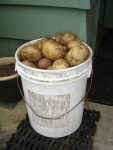 I have grown potatoes in horse troughs for several years now. In the summer of 2016, when the foliage dried up and the soil was dry, I pulled the stock tank drain plug insuring no water was in the water chamber in the bottom of each trough for the winter months. I decided to leave the potatoes in the dry soil and cover with 12” of straw, to keep the sunlight off the potatoes and to protect them from a freeze the winter months might bring. Be sure to cover the troughs with plastic to keep the soil dry throughout the winter and spring so the potatoes wouldn’t rot or start sprouting.
I have grown potatoes in horse troughs for several years now. In the summer of 2016, when the foliage dried up and the soil was dry, I pulled the stock tank drain plug insuring no water was in the water chamber in the bottom of each trough for the winter months. I decided to leave the potatoes in the dry soil and cover with 12” of straw, to keep the sunlight off the potatoes and to protect them from a freeze the winter months might bring. Be sure to cover the troughs with plastic to keep the soil dry throughout the winter and spring so the potatoes wouldn’t rot or start sprouting.
This was an outstanding discovery knowing we have juicy plump potatoes waiting for the picking when needed. But come May, the few potatoes that were left in one trough did start sprouting. Still, they were awesome potatoes, so I picked off the sprouts and consumed the spuds.
Potatoes Just Outside Back Door
 It is very handy being able to dig potatoes just outside the back door. We turned our back patio into a horse trough garden initially, and now I pick up other tubs at thrift stores, build water chambers in the bottom of the tubs, and grow just about everything.
It is very handy being able to dig potatoes just outside the back door. We turned our back patio into a horse trough garden initially, and now I pick up other tubs at thrift stores, build water chambers in the bottom of the tubs, and grow just about everything.
Several years ago I discovered gardening in horse troughs on the Internet, with water chambers where the roots of plants uptake the water when needed. We are “blessed” with hard clay soil where we live, so this new found gardening method made it possible to grow lush produce of all types with great success and to do so in a small space.
I bought 6’ long, 2’ wide horse troughs, built water chambers in the bottom of each trough. If one buys more than one horse trough, buy the exact same size to minimize one’s work in making the water chambers. Let me explain the process in developing water chambers, whether in horse troughs or any other tub deep enough to facilitate a water chamber and still have ample soil (at least 14” to 16” of soil) for growing.
Developing Water Chambers in Horse Troughs or Tubs
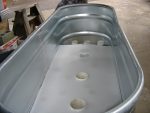 For each horse trough I used 3” to 4” diameter (what was on hand or picked up at a Reuse Store) round PVC pipe cut into 5” lengths. You can cut shorter depending on the depth of the container and still have enough soil to grow. The PVC pipe sets on end on the bottom of the trough to support the sheet of perforated soffit barrier that holds the soil. I used soffit material (this is used in over hangs of homes for ventilation to the attic) and zip tied together to create the width needed.
For each horse trough I used 3” to 4” diameter (what was on hand or picked up at a Reuse Store) round PVC pipe cut into 5” lengths. You can cut shorter depending on the depth of the container and still have enough soil to grow. The PVC pipe sets on end on the bottom of the trough to support the sheet of perforated soffit barrier that holds the soil. I used soffit material (this is used in over hangs of homes for ventilation to the attic) and zip tied together to create the width needed.
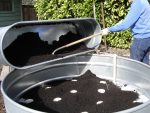 There is another product out there. It’s 3/16” thick polypropylene perforated ridged material that comes in 4’x8’ sheets, but it’s a very expensive product and one has to use a jig saw to cut this product. I drilled many holes in each round PVC support to displace water as the chamber fills with water. I placed the supports all over the bottom of each trough (approximately 20 per trough to support the soffit barrier).
There is another product out there. It’s 3/16” thick polypropylene perforated ridged material that comes in 4’x8’ sheets, but it’s a very expensive product and one has to use a jig saw to cut this product. I drilled many holes in each round PVC support to displace water as the chamber fills with water. I placed the supports all over the bottom of each trough (approximately 20 per trough to support the soffit barrier).
Use Cardboard To Make A Pattern For Soffit Barrier
I accumulate cardboard to make a pattern, taped the cardboard together, and then turned over one trough to score the shape of the trough onto the cardboard for the soffit barrier pattern to cut the correct size needed. Using the cardboard as a pattern, I then zip tied soffit material together then used a Sharpie pen to mark where to cut with tin snips. I always do some final trimming to the soffit material so it lays snug in the trough on the round PVC supports at the bottom of the tough or tub.
Soffit Cut
Five holes were drilled in the soffit barrier with a hole saw then placed the 6” long round PVC tubes on end setting on the bottom of the trough. I prepare the PVC tubes by drilling many holes to displace the water. At one end of the soffit material, use a hole saw to drill a hole approximately ½” from the edge of the soffit material to insert a 1½” PVC filler pipe 24” long. Cut the bottom end of the filler pipe at a 45 degree angle.
This fill pipe is how you fill the water chamber. The fill pipe extends above the top of the horse trough or tub. At the same end of the trough as the fill pipe drill a ¼” hole in the side of the horse trough or tub the height of the soffit platform so when filling the water chamber you’ll know when the chamber is full; it’s full when water spews out the small hole in the end of the trough.
Wicking Tubes
 Now, let’s get back to the wicking tubes, the 6” long tubes extended into the water chamber. Set them on the bottom of the trough or tub, and when dumping dirt onto the soffit barrier I fill the 6” PVC round wicking tubes with dirt. The dirt extends down into the water chamber. Take your fist and pack the soil into the PVC wicking tubes.
Now, let’s get back to the wicking tubes, the 6” long tubes extended into the water chamber. Set them on the bottom of the trough or tub, and when dumping dirt onto the soffit barrier I fill the 6” PVC round wicking tubes with dirt. The dirt extends down into the water chamber. Take your fist and pack the soil into the PVC wicking tubes.
The wicking tubes wick up the water up into the dirt setting on the soffit barrier. The plants take as much moisture as they need when they need it. There is no evaporation with this watering system, and in the heat of the summer months, I fill the water chambers approximately every three to four days. I use a thin wood dip stick to check whether the water chambers need filling using the fill pipe. The initial expense and work setting up the water chambers in the horse troughs or tubs is well worth it!
Water Chambers Last For Years
Water chambers last for years. I’m going on seven years now with no signs of any deterioration of the horse toughs. I add compost every year to the soil to keep replenishing nutrients for the next growing season.
Plastic Tanks In Winter
When using plastic tubs without a stock tank drain plug to drain the water from the water chamber for the winter months, one must siphon or pump the water out through the fill pipe in the fall to keep the plastic tub in good condition and keep water from freezing in the water chamber, which can crack the plastic tubs. Cover the tub with plastic to keep rain from filling up the water chamber during the winter in frost zones.
Plastic tubs only last a few years due to the sun; but if you replace with the exact same size tub you can reuse all the water chamber soffit and supports in the new tub. There is nothing you can’t grow with this system of gardening. To name a few crops you can winter, I will list a few things such as herbs, beets, and even grow carrots through the winter months and then pull them up when needed, it’s a great way to grow produce.
Benefit of Horse Trough Gardening- Much Earlier Garden
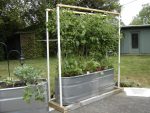 You can start your garden much earlier in the spring than those gardening in the ground. One can even hoop with plastic after planting to help the germination of seeds, if the spring is unusually cool or wet. One can use glass shower doors on top of the troughs to warm up the soil. I used 4×4’s to built a rectangular platform on the ground and then drilled holes to support grey PVC hoops to go over the troughs. Using the grey ½” to ¾” PVC is a better choice. It’s easier to bend and the grey PVC last a long time. There are no weeds or very few, and no bending over to work the soil and plant. This method is great for gardeners with back issues who want to keep growing a garden.
You can start your garden much earlier in the spring than those gardening in the ground. One can even hoop with plastic after planting to help the germination of seeds, if the spring is unusually cool or wet. One can use glass shower doors on top of the troughs to warm up the soil. I used 4×4’s to built a rectangular platform on the ground and then drilled holes to support grey PVC hoops to go over the troughs. Using the grey ½” to ¾” PVC is a better choice. It’s easier to bend and the grey PVC last a long time. There are no weeds or very few, and no bending over to work the soil and plant. This method is great for gardeners with back issues who want to keep growing a garden.
Growing Pole Beans and Tomatoes
I do have to use a ladder to pick my pole beans that climb a cattle panel erected next to the horse trough. Tomatoes do awesome with this water chamber system. Even though they say let the plants stress a little before watering again, but with this system I’ve never had a bad tomato crop, and they up take the water when they need it. It’s always available for the plant’s use.
New Possibilities If Limited On Space in Yard or Deck
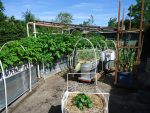 If one is limited on space in their yard or deck, this method of gardening opens up new possibilities. With a little time, effort, and initial expense, you too can make it happen. One can even hoop their troughs or tubs to extend the growing season. The possibilities are endless! I do put a layer of straw or chips on top of the soil after planting to help keep the top soil from getting dry. This is just another extra added amenity to propagate healthy soil.
If one is limited on space in their yard or deck, this method of gardening opens up new possibilities. With a little time, effort, and initial expense, you too can make it happen. One can even hoop their troughs or tubs to extend the growing season. The possibilities are endless! I do put a layer of straw or chips on top of the soil after planting to help keep the top soil from getting dry. This is just another extra added amenity to propagate healthy soil.
Tubs On Dollies For Ease of Moving and Netting to keep Flies Off
I place tubs on dollies for ease of moving around the patio if needed. The yellow netting on the oval galvanized tub is to keep Leaf Minor Flies off the Beet leaves. Very successful!
Window Screens Keep Birds and Squirrels From Digging
 After planting seeds, I place window screens (obtained from a screen repair shop for free) on the troughs and tubs to keep the crows, blue jays, and squirrels from digging up the freshly planted seeds. Some are picked up from a thrift store so I could mound the potatoes as they grew. Google “Horse Trough Water System” to see how it’s done ☺
After planting seeds, I place window screens (obtained from a screen repair shop for free) on the troughs and tubs to keep the crows, blue jays, and squirrels from digging up the freshly planted seeds. Some are picked up from a thrift store so I could mound the potatoes as they grew. Google “Horse Trough Water System” to see how it’s done ☺
SurvivalBlog Writing Contest
This has been another entry for Round 73 of the SurvivalBlog non-fiction writing contest. The nearly $11,000 worth of prizes for this round include:
First Prize:
- A $3000 gift certificate towards a Sol-Ark Solar Generator from Veteran owned Portable Solar LLC. The only EMP Hardened Solar Generator System available to the public.
- A Gunsite Academy Three Day Course Certificate. This can be used for any one, two, or three day course (a $1,095 value),
- A course certificate from onPoint Tactical for the prize winner’s choice of three-day civilian courses, excluding those restricted for military or government teams. Three day onPoint courses normally cost $795,
- DRD Tactical is providing a 5.56 NATO QD Billet upper. These have hammer forged, chrome-lined barrels and a hard case, to go with your own AR lower. It will allow any standard AR-type rifle to have a quick change barrel. This can be assembled in less than one minute without the use of any tools. It also provides a compact carry capability in a hard case or in 3-day pack (an $1,100 value),
- Two cases of Mountain House freeze-dried assorted entrees in #10 cans, courtesy of Ready Made Resources (a $350 value),
- A $250 gift certificate good for any product from Sunflower Ammo,
- Two cases of Meals, Ready to Eat (MREs), courtesy of CampingSurvival.com (a $180 value), and
- American Gunsmithing Institute (AGI) is providing a $300 certificate good towards any of their DVD training courses.
Second Prize:
- A Model 175 Series Solar Generator provided by Quantum Harvest LLC (a $439 value),
- A Glock form factor SIRT laser training pistol and a SIRT AR-15/M4 Laser Training Bolt, courtesy of Next Level Training, which have a combined retail value of $589,
- A gift certificate for any two or three-day class from Max Velocity Tactical (a $600 value),
- A transferable certificate for a two-day Ultimate Bug Out Course from Florida Firearms Training (a $400 value),
- A Trekker IV™ Four-Person Emergency Kit from Emergency Essentials (a $250 value),
- A $200 gift certificate good towards any books published by PrepperPress.com,
- A pre-selected assortment of military surplus gear from CJL Enterprize (a $300 value), and
- RepackBox is providing a $300 gift certificate to their site.
Third Prize:
- A Royal Berkey water filter, courtesy of Directive 21 (a $275 value),
- A large handmade clothes drying rack, a washboard, and a Homesteading for Beginners DVD, all courtesy of The Homestead Store, with a combined value of $206,
- Expanded sets of both washable feminine pads and liners, donated by Naturally Cozy (a $185 retail value),
- Two Super Survival Pack seed collections, a $150 value, courtesy of Seed for Security, LLC,
- Mayflower Trading is donating a $200 gift certificate for homesteading appliances, and
- Two 1,000-foot spools of full mil-spec U.S.-made 750 paracord (in-stock colors only) from www.TOUGHGRID.com (a $240 value).
Round 73 ends on November 30th, so get busy writing and e-mail us your entry. Remember that there is a 1,500-word minimum, and that articles on practical “how to” skills for survival have an advantage in the judging.

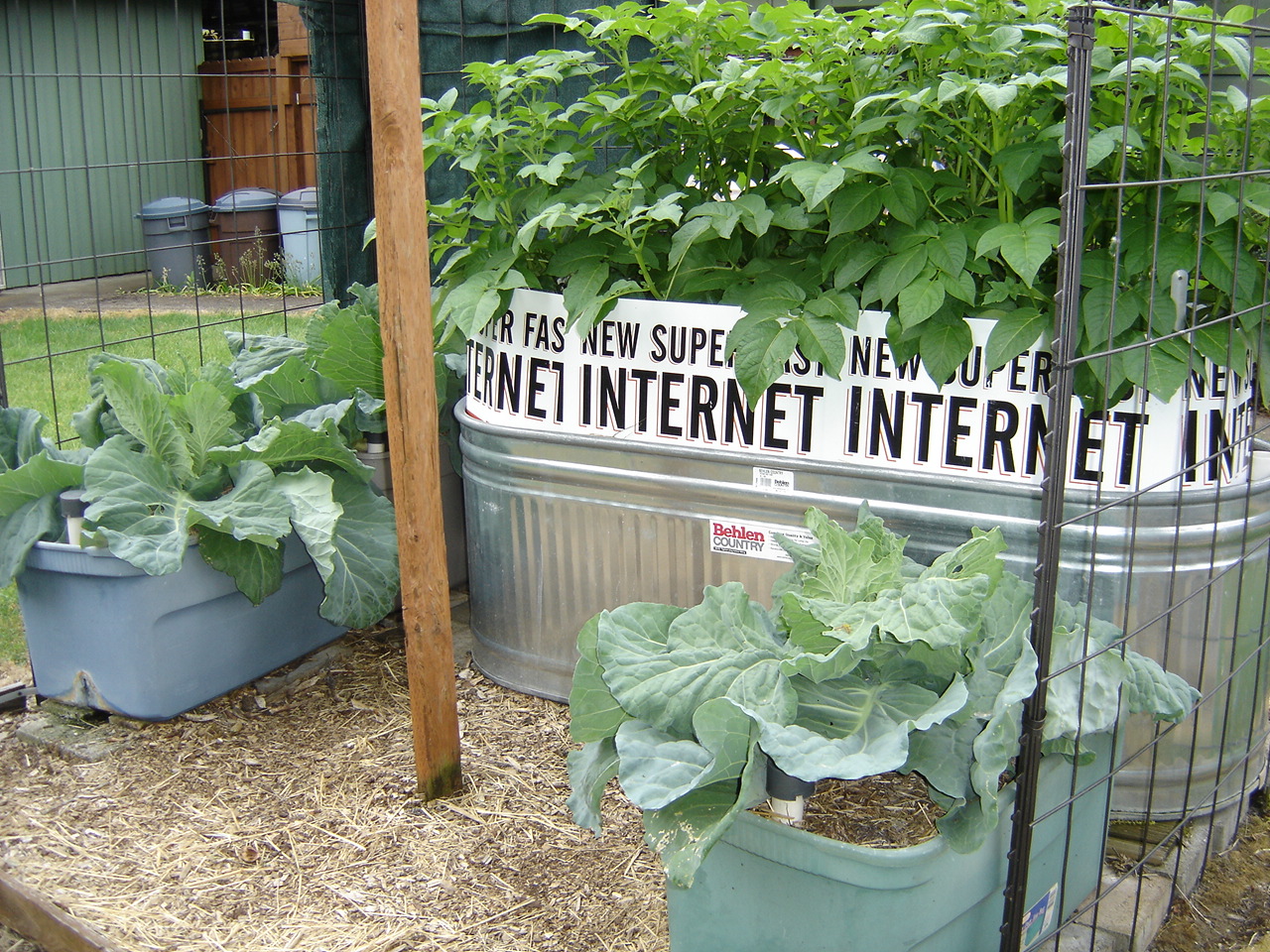









Very interesting and informative article. I have tried a variety of potted and raised beds and all have some advantages or disadvantages. The key to growing a garden that has good output is soil moisture level, not too much or too little and managing pests and weeds. This method seems to have them all covered. I think this would particularly work for one of my crops I have a hard time harvesting. Sweet potatoes. The vines go everywhere and it seems like I have to dig up the entire garden to find them. I think this would keep the vines from running and the sweet potatoes in one place. Thank you for sharing.
Would you ever put fertilizer in the water?
Test soil PH before planting and adjust ph for the crop you are planting with Lime or finely mulched leaves. I do not use fertilizer in the water. I put it in a trench off to one side of what ever crop I’m planting.
You would be better off buying your potatoes from a local farm. This is a really cute, busy, expensive hobby. There is a reason for our ancestors using root cellars. Stop buying metal horse troughs and plastic and dig a hole in the ground. Store everything, potatoes, carrots, and your canned goods. Stop trying to re-invent the wheel. PS, they make great fallout shelters as well.
The whole point about survival issues is NOT depending on the store!!! Your dig a hole in the ground comment makes me worry about your survival in a SHFT situation! I thought the ideas were outstanding since it was gleaned through experience and not just theory.
Amen!
I am not handy, but could handle the materials here. However, I would greatly appreciate it if the author would provide a series of step by step photos to go with each step of the instructions. I was able to figure out most of it, but most is not good enough when you are growing food to survive.
Would the editor be willing to ask the author for more photos, and update the post? This is one of the most useful posts I have read, and I’ve been reading Survivalblog for about ten years.
This is a variation of the Alaskan grow buckets. I have seen similar setups using totes. Good idea, but expensive. Does anyone have suggestions for large horse trough sized containers that aren’t expensive? Perhaps 55 gallon drums which I can buy for $10 apiece.
How do you keep the soil from pushing the soffit material to the bottom of the tank?
PVC pillars that do not pierce the soffit material like the wicks would.
strange, I plant 200-250 plants every season and harvest 500-600lbs of potatoes each season. I store them 18″ x 18″ x 14″, layered with newsprint inside wood slat boxes inside a subterranean root cellar, September till May/June. temps ranges no cooler than 39f and no warmer than 61f. outside temp swings winter to summer is -30f to 110f. by planting season, I have enough left over for new seed crop and the rest is shredded in hash browns/frys and frozen for one more year of human use. after two years, I will feed the chickens the hash browns/frys left overs and replace with new batch. full circle farming.
What is the size (inside diameter) of the wicking tube’s?
This is a neat idea. I am 63 and for the past 5yr I have been working to get my “garden” into raised beds as much as possible, except for the corn and green beans which I grow in volume out in the back yard garden plot. I hope to get it completed before my back gives out. 🙂 I hate the thought of having to give up a garden because I can’t bend over.
I was wishing for a youtube step by step for this. Or more details with pictures.
I already have my taters in a raised bed and love it.
Raised beds are excellent for us old folks !
If I used this process with smaller container(s) to start on a smaller scale, would any aspect be different? Also, we have a diabetic in the house & would grow sweet potatoes.
Never mind I can now see in the photo that there are several tubes supporting the mesh.
Google Global Buckets. step by step for similar type of gardening
Great article and I’ve been looking at alternatives for raised bed gardening, and this technique is certainly appealing, not to mention the simple ingenious techniques – love the window screen idea! Planted a big container, waited patiently for the sprouts only to see them all eaten by the birds!
Since I don’t have a green thumb, and I’m a new gardener that relies on other’s proven “recipes” for success plus a little science to maximize my crop – appreciate you sharing your experience. Like the idea of getting the right soil for each crop based on the climate.
Did a quick search and you can buy the 100-120 gallon troughs (6’ x 2’ x 2’, and each weigh about 70 lbs.) for about $120 at tractor supply or mills fleet farm. if you get 10 years out each, then the marginal cost is $10 per year, add the cost of soil preparation, mulching and organic fertilizers and you likely spend another $10-20 per trough. So, the marginal cost is maybe $40 per year (my marginal cost is low since I get the personal satisfaction of growing my own) – the real question is what’s the yield? If you can get 40 to 80 lbs. per trough, then you are equal to the cost of No.1 grade taters from the local grocery store – that’s a win in my books for getting a little self sufficiency that others don’t have or want, plus bragging rights at dinner table too!
Where I live, can see the troughs getting toasty hot in full sun, do you run risk of the soil temps getting too hot or does the watering system keep the temperatures down? Like the low tech self watering approach – I’ve lost or stunted my modest crop after only a day of hot weather.
What are the best yielding crops for your technique? Looking to add beets, root veggies, carrots, squash, and straw berries to my garden in the future.
Please share your tater yields from a trough and perhaps other crops using the same technique.